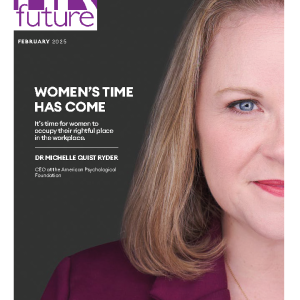There’s been a lot of recent talk about how corporate culture has become “too feminine,” and that it’s time to bring back a more “masculine” energy—more directness, less emotion. In that spirit, this article is written with exactly that energy: data-driven and direct. Because the facts don’t need softening.
This piece explores representation, motherhood, menopause, mental health, and the need for U.S. women to have flexibility in the workforce. It includes additional reading suggestions to dive deeper, recruitment marketing tips for employers, and tips for women job seekers.
Key Takeaways
- Women’s representation in leadership still lags—despite outpacing men in higher education.
- Caregiving and motherhood continue to impact career growth, with too few family-friendly benefits.
- Mental health, menopause care, and flexibility are essentials—not perks.
There is no doubt women in the U.S. workplace have made much progress over time, though they still fall below the Organization for Economic Co-operation and Development (OECD) average in the Economist Glass Ceiling Index, which measures 10 different indicators across factors like labor force participation, pay, and parental leave.
In 2025, the labor market is increasingly challenging for women, in part due to the rollback of diversity, equity, and inclusion initiatives. This trend feels especially disheartening this month, as we see a noticeable decline in the emphasis on Women’s History Month across government, higher education, and the private sector. I can’t help but wonder if this is a driving factor of Zip’s latest job seeker confidence survey, which shows that women’s confidence fell quite considerably over the quarter.
There is also a rise in perception that women should go back to “traditional roles,” according to a New York Times article covering recent survey results from the Views of the Electorate. Among Republican men, this view jumped 28% since 2022 and now sits at almost half (48%).
Many downstream impacts of concern could arise from this, including societal pressures for women to exit the labor market, making them more economically vulnerable. Longer term, if girls grow up with fewer women working it may limit their own ambitions.
For a deeper look at how perceptions of DEI have shifted, don’t miss this insightful opinion piece in Bloomberg. Data from the National Bureau of Economic Research and the Pew Research Center offer a notable perspective on who continues to hold power in today’s labor market.
Women Remain Underrepresented at Every Stage of Their Career
Women currently remain underrepresented in the workforce and at every stage of the career journey. According to McKinsey’s latest women in the workplace report, for every 100 men promoted to manager, only 89 White women received the same advancement. And that number drops significantly to just 54 for Black women. This disparity is especially striking given that women far exceed men in educational attainment at the graduate level. According to the National Center for Education Statistics’ most recent data, women earn 63% of all master’s degrees and 57% of doctoral degrees.
McKinsey also shared data that breaks down representation by gender and race from entry-level roles to the C-suite. The chart below tells the full story, but here’s the headline: Women hold 48% of entry-level positions yet that number drops to 29% by the time they reach the C-suite.

If you want to dig deeper into women’s representation in leadership, take a look at LinkedIn’s 2025 State of Women in Leadership report. The data makes it clear that at every step up the career ladder women’s presence declines.
Employer Tips: Be transparent about your DEI efforts—if you’ve cut programs, be honest about what’s next. Audit your job descriptions for biased language and publicly share your company’s gender and diversity hiring data. Lastly, use video storytelling in your recruitment marketing ads to showcase women in leadership. Stories around growth could be particularly impactful.
Job Seeker Tips: Before accepting an offer, ask, “How does this company support women’s career growth?” Or, “What percentage of leadership roles are held by women?”And don’t just ask about leadership diversity—check LinkedIn. If the leadership team is all men, that information may help with your decision.
Motherhood and Caregiving Shouldn’t Come with a Career Penalty
Working moms, this next section is for you because motherhood in 2025 is still a career risk. The data shows that 41% of working mothers report facing discrimination, from stalled promotions to job loss. From a participation perspective, mothers’ labor force participation had returned to pre-pandemic levels in 2023, however, the gender gap in labor force participation remains significant, 73.7% for mothers compared to 94.9% of fathers. For more on mothers and labor force participation, check out the latest research from the Institute for Women’s Policy Research 2025 report.
One major barrier to labor participation for women is childcare. KPMG publishes a fascinating Parental Disruption Index and according to their research, women are disproportionately impacted when it comes to missing work, whether it be full-time or part-time, due to childcare problems. In February 2025, 1.5 million workers either worked part-time or missed work entirely due to childcare problems. Eighty-six percent of these were women.
It’s also worth noting that women, particularly working mothers, feel pressure to focus on responsibilities at home. About half of employed women (48%) report feeling a great deal of pressure to focus on their responsibilities at home, compared with 35% of employed men. Among working mothers with children younger than 18 in the household, two-thirds (67%) say the same, compared with 45% of working dads.

Many women are also navigating the emotional and physical challenges of trying to conceive. As many as one in six face fertility struggles yet workplace support remains limited, with just 12% of companies offering benefits like IVF or egg freezing. Because the cost of fertility treatment is so high, women need support from their employers. Sixty-nine percent of employees have taken, considered taking, or might take a new job because better reproductive and family benefits are offered, according to the Maven Clinic’s 2025 report. This topic is clearly top of mind.
Mothers, and fathers, also need support when suffering miscarriages. As of March 2025, the UK now offers two weeks of paid bereavement leave for a miscarriage. Pregnancy loss is not only a personal tragedy, but a workplace issue that deserves compassion and policy support. U.S. companies should follow suit. When I experienced a miscarriage, there was no official policy in place—but my boss (shout out Angie Boyd Chambers) gave me the option to work from home the entire week and extended an incredible amount of support. I’ll never forget that. It shouldn’t come down to the luck of having an understanding manager—every employee deserves thoughtful leave and care during that kind of loss.
I’d be remiss to not include one final topic in this section, and that is paid leave. The charts below are eye opening when comparing the U.S., the red line, to the OECD average (dotted line), and the rest of the countries (solid grey lines). Notice that costs in the U.S. are higher than most other countries at 33% of the average wage. At the same time, there is no red line for the U.S. at all for paid leave, because the U.S. provides no support in this area. Read the full analysis by the Economist here.

In a tight labor market, offering comprehensive benefits to support women helps a company stand out. There is a business case for it as organizations with parental leave policies, as one example, retain 63% more women. And as anyone can tell you, the cost to retain is much more affordable than the cost to recruit.
Employer Tips: Ensure hiring managers don’t penalize gaps on a resume. Highlight paid parental leave, childcare support, and fertility benefits clearly in job postings. And actively promote returnship programs to support mothers re-entering the workforce.
Job Seeker Tips: Look for companies offering “returnship” programs. Use this list to start. Ask to speak to other working moms in the company as a part of the interview process to gain an understanding of what support is available for working moms.
Getting Paid What You Deserve (Because the Wage Gap Still Exists)
Twenty-one percent of men, compared to 9% of women, say gender pay gaps are not real, according to the latest Talker Research Study, as reported by New York Post. Perceptions are quite split between political parties with 24% of Republicans reporting it doesn’t exist, compared to 7% of Democrats. So, what does the data show?
Despite pay transparency laws, women still earn less than men for the same work. Gaps are wider for some women. According to an American Association for University Women (AAUW) report, for every one dollar a White man earns, White women fare best and make 83 cents. Black women earn 66 cents, followed by Latina women at 58 cents.
An analysis by the HRC Foundation revealed that LGBTQ+ workers are also impacted more by the pay gap. The data found that women in the LGBTQ+ community earn 87 cents for every dollar full time workers earn, and this drops to 60 cents for trans women.
Wage gaps, according to Future Forward Women, can also vary by state. Women in Mississippi and Alabama, as an example, earn significantly less than men. Whereas, states like DC, Rhode Island, and Massachusetts have some of the smallest gaps in pay. DC has the highest median earnings for women at $87,028. To dig in further on pay gaps, check out the latest Pew Research Center.
Employer Tips: Post salary ranges in job listings, and conduct and publish pay audits to show how your company is closing gaps. Women are more likely to apply when pay is listed upfront.
Job Seeker Tips: Use pay transparency tools like Glassdoor, LinkedIn, or Indeed Salary Insights before negotiating. Know your worth because pay equity should be non-negotiable.
Prioritizing Mental Health and Avoiding Burnout
Women are burning out at record levels. Sixty-eight percent of women report higher stress levels than men and women are twice as likely to experience burnout, according to Gallup. And the problem with mental health is getting worse, especially for Gen Z women as noted in the chart below.
Comparing results from 2020-2024 with 2010-2014, Gallup found that the percentage of 18- to 29-year-old women reporting excellent mental health has dropped 27 points to 24%, and the percentage among 30- to 49-year-olds is down 16 points to 30%.

While mental health has been declining for women, the average cost of counseling is out of reach for many and can fall anywhere between $100 and $300 per session. With America’s mental health the least positive in the 24-year history of Gallup’s poll, it’s clear that additional support and resources are needed.
Employer Tips:Offer mental health benefits like therapy stipends or wellness days. Respect boundaries and don’t push an always-on expectation. Listing burnout prevention initiatives in job ads could also be appealing. More than three days off with bereavement leave and bereavement for extended family, friends, or pets could be a differentiator and go a long way for positive mental health.
Job Seeker Tips: Ask about mental health support in interviews. Look for responses with concrete policies, not just “we support self-care.”
Flexibility – Finding Work that Fits Your Life
Flexibility is a popular topic and it may even feel like overkill to some, but it can’t be ignored, particularly when it comes to recruiting women. Women job seekers are looking for jobs that fit their life. The data in a recent HiBob U.S. 2025 Women Professionals in the Modern Workplace article, shows that 48% of women want a four-day work week. Beyond that, many would even delay a promotion or trade in higher pay for more flexibility. Benefits for a four-day work week for women are widespread, but two that top the list are reduced child care costs and support for burnout. And with return-to-work (RTO) policies kicking back in full swing, demand from job seekers and employees for companies to couple that with child care support or resources is growing, according to a recent HR Brew article.
Related to flexibility, one idea to pull more women into the workforce would be to offer micro-shifts that provide consistent scheduling. This is especially impactful for single moms or caregivers. Offering shift work that aligns with a school schedule, as an example, would provide the flexibility and stability moms need to accommodate their pick up and drop off responsibilities.
Employer Tips: Don’t make assumptions about what candidates know about your policies. If you offer flexible arrangements like hybrid, remote, or other alternative schedules, mention it prominently in job ads. Highlighting real stories of women who have built successful careers at your company while working a flexible schedule would make great video content.
Job Seeker Tip: Fully remote jobs are definitely on the decline. But, if flexibility is a priority, negotiate it upfront.A company may be open to a hybrid or other alternative work schedule that they didn’t publicly share in the job ad. And if you are really serious about valuing a four-day work week, ask for a pro-rated option.
Menopause and Access to Healthcare
Access and resources for adequate healthcare, including menopause support, directly impact women’s careers. Future Forward Women recently reported the state by state rankings for women and their health and states with the lowest scores. Texas, Tennessee, Oklahoma, Nevada, and Mississippi have the worst access to reproductive health and the highest maternal mortality rates. These states may have a harder time recruiting women. This is particularly pronounced in healthcare, especially for doctors who are responsible for providing care for women.
As a job seeker, if an employer-sponsored healthcare plan is a critical factor in your employment decision, look for jobs in states where coverage is more accessible. States like DC, Hawaii, Rhode Island, Vermont, and Delaware all top the list in the report as places with better healthcare access and lower uninsured rates. Oregon, Maryland, DC, and Massachusetts also have the strongest policies on paid leave, another critical factor impacting women’s health.
Menopause, a critical factor for mid-career women, is not discussed frequently enough in most workplaces, though as of late it is picking up steam. It impacts millions of women each year causing symptoms like anxiety, fatigue, and brain fog, to name a few.
Despite the major impact menopause can cause women personally and professionally, only 15% of companies offer menopause benefits, which is unfortunate since symptoms tied to menopause cost employers nearly $2 billion annually, as reported by the New York Times.
Employer Tips: Ensure your health insurance coverage offers menopause-related care. Create a culture where age is not a disadvantage. It’s also important to make sure leadership teams have adequate women representation and that support groups like ERGs for women 40+ are in place to support career longevity. For additional information on how your company can support women entering menopause, check out this informative Harvard Business Review article.
Job Seeker Tip: Look for companies that offer menopause-specific benefits. They signal a workplace that values women beyond their 30s. Here is a list of 9 to get started.
Final Calls to Action
Here are three final calls to action. First, if you’re a woman staying in your current role with no plans to leave, use the insights from this article to advocate for fair and equitable workplace policies—not just for yourself, but for all women in your organization.
Second, if you have a woman partner or spouse and you’re raising children together, make sure you’re providing equitable support at home and with childcare. The goal is to prevent the woman in your life from shouldering an unfair share of unpaid labor or reaching burnout without support. Personal shout out to my husband, Justin Roth, for excelling at this one.
And finally, if you’re a leader with women reporting to you, take what you’ve learned here and put it into action. Be aware of the unique challenges women face and set aside any personal skepticism about whether pay gaps or inequities exist. Focus on ensuring equal opportunity, support, and access to advancement for women on your team. After all, equity isn’t a women’s issue—it’s a leadership issue.
Thank you to Kara Somsen Diem Sarah Wilson Barton and Suzanne Kosmerl for helping me get this article right.



























